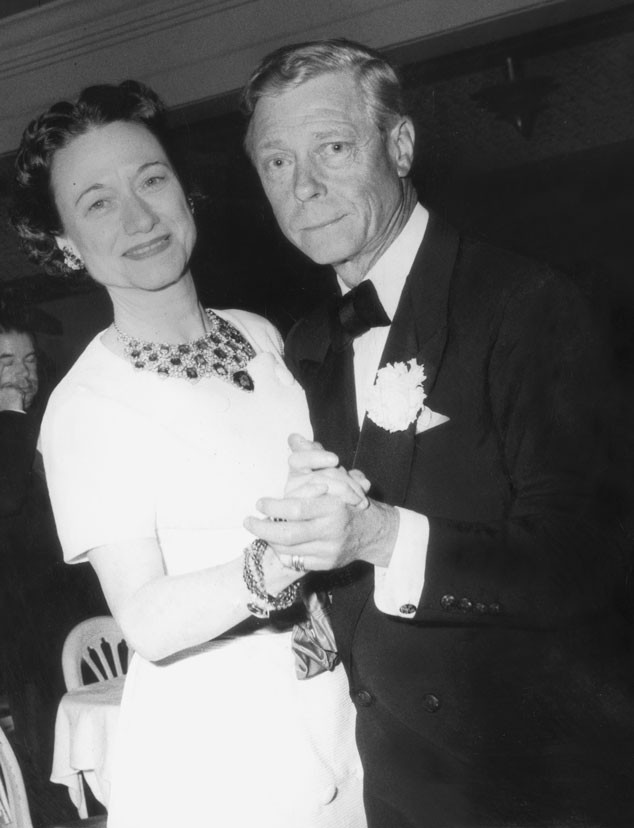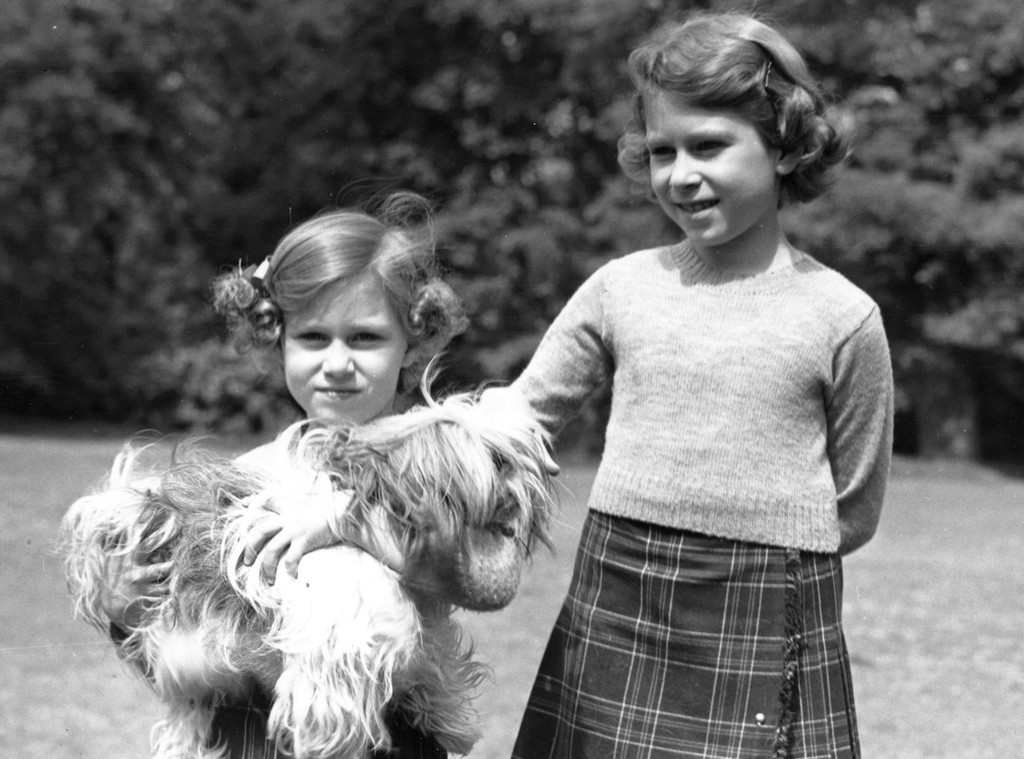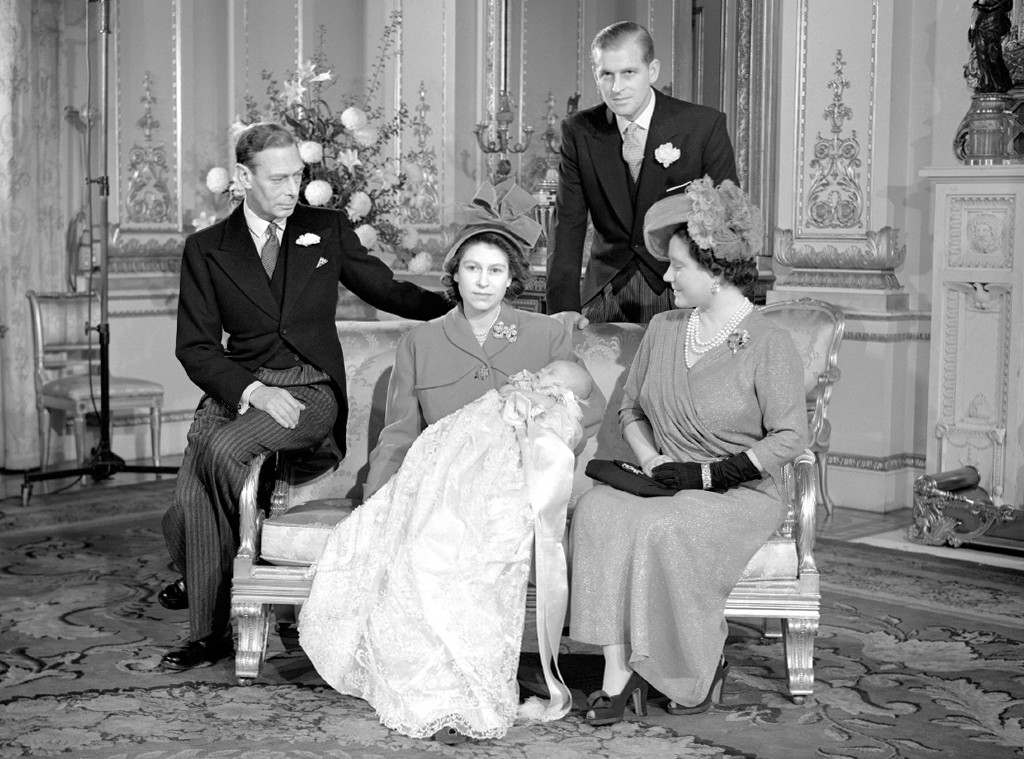
Getty Images/Shutterstock; E! Illustration
Heavy was the head that assumed the crown 68 years ago.
Elizabeth Alexandra Mary Windsor became queen of the United Kingdom and the Commonwealth on Feb. 6, 1952, but it was a sorrowful day, as her accession technically occurred the moment her father, King George VI, died.
And that is why, though Feb. 6 remains a historic date, Queen Elizabeth II does not demonstratively mark Accession Day in any way, let alone celebrate it. Instead, she usually spends the day in private reflection at Sandringham House, in Norfolk.
She did so once again this year, after which she returned to Buckingham Palace, where she was able to spend a few weeks before she and Prince Philipleft to do their COVID-19 physical distancing at Windsor Castle. That’s where she delivered only the fifth televised special address in her storied reign to boost Britain’s morale as the pandemic took its toll.
It’s been business as usual since then, albeit close to home and via video. Philip just celebrated his 99th birthday on June 10, and on June 13 a small military ceremony will be held in the Quadrangle at Windsor Castle to mark the queen’s official birthday (as opposed to her biological one on April 21). The annual Trooping the Colour, the usual grand military parade that honors the queen in June, was canceled back in March because of the COVID-19 outbreak.
Now 94 years old and Britain’s longest-reigning monarch ever, one wonders if she has ever spent much time dwelling on the turn her life took, the fact that—though she was born a princess, third in line to the throne, and groomed from an early age for the most public of public service—becoming queen wasn’t a given at all.
Elizabeth—or Lilibet, as her family affectionately called her—was very close to her grandfather, King George V, a grandson of Queen Victoria who was, as a second-born son, considered a spare heir.
But George V’s older brother, Prince Albert Victor, died at only 28—of pneumonia during a flu epidemic—making George the presumptive heir. (Amid the endless layers of conspiratorial lore surrounding the royal family, it’s been suggested that Albert was Jack the Ripper; thanks to documentation of his whereabouts, he appears to have alibied out.)
George V ascended to the throne on May 6, 1910, when his father, King Edward VII, died. He and his wife, Queen Mary, had six children (their youngest, Prince John, suffered from severe epileptic seizures and died in his sleep at 13).
Prince Edward Albert Christian George Andrew Patrick David (he went by David) was George and Mary’s eldest, followed by brother Albert Frederick Arthur George. (Are these names starting to sound familiar?)

Bob Thomas/Popperfoto/Getty Images
Albert married Elizabeth Bowes-Lyon in 1923 and they became the Duke and Duchess of York. They had two girls, Elizabeth and Margaret. But David remained a bachelor, cycling through—and sticking with—various affairs, including a 16-year relationship with the very married Freda Dudley Ward.
One school of thought is that Albert’s wife was actually in love with David, who despite being, by many accounts, a not particularly impressive man and possibly not mentally stable, was easily the most eligible bachelor in Britain—made all the more so when he became King Edward VIII on Jan. 20, 1936, when George V died.
By then, however, David had already lost his heart to Wallis Simpson (née Warfield), the soon-to-be twice-divorced American who, with Britain also on the brink of war with Germany, no less than helped reroute the course of history.
“My theory is that the Queen Mother was really rather in love with the Duke of Windsor and probably would have quite liked to have married him,” Hugo Vickers, author of the Wallis Simpson biography Behind Closed Doors, told NPR in 2011. “It must have passed through her mind. And I think it suited her very well to present the Duchess of Windsor as the woman who stole the king. And people rather swallowed that line.”

Hulton Archive/Getty Images
Elizabeth was very close to her paternal grandfather and in a Nov. 6, 1935, diary entry, an ailing George V wrote that he hoped his oldest boy, David, wouldn’t have an heir, so that the crown would then pass to Albert and then, eventually, to Elizabeth.
King Edward VIII abdicated for love on Dec. 11, 1936, vaulting his brother Albert onto the throne as King George VI.
“Does that mean that you will have to be the next queen?” 6-year-old Margaret Rose asked her 10-year-old sister, Lilibet. “Yes, someday,” Lilbet said.
“Poor you,” Margaret replied.

Lisa Sheridan/Studio Lisa/Getty Images
But Elizabeth’s childhood went on as scheduled, at least until the onset of World War II changed the entire United Kingdom’s fortunes for the foreseeable future. The princess and presumptive heir gave her first radio address from Windsor Castle at the age of 14, on Oct. 13, 1940, during the BBC Children’s Hour.
“Thousands of you in this country have had to leave your homes and be separated from your fathers and mothers,” the teen said. “My sister Margaret Rose and I feel so much for you as we know from experience what it means to be away from those we love most of all. To you, living in new surroundings, we send a message of true sympathy and at the same time we would like to thank the kind people who have welcomed you to their homes in the country.”
At 16 she joined the women’s branch of the British Army, the Auxiliary Territorial Service, and became 2nd Lt. Elizabeth Windsor, vehicle mechanic. And by then, she had lost her heart to a dashing Royal Navy officer.
Prince Philip of Greece and Denmark, who was born on the Greek isle of Corfu in 1921, had been tasked with entertaining a 13-year-old Elizabeth when she and her family visited the Royal Naval College at Dartmouth in 1939—Philip being one of the healthy cadets during a chickenpox and mumps epidemic coursing through the school. The princess was smitten with the 18-year-old Philip (who like her was one of Queen Victoria’s great-great-grandchildren), and they proceeded to write each other throughout the war.
In 1944, Philip’s cousin King George II of Greece asked Britain’s King George VI and Queen Elizabeth if they thought Philip might be a desirable match for their daughter. Queen Mary, young Elizabeth’s grandmother, had been following Philip’s successful naval career and apparently thought it was a great idea.
George VI agreed that Philip had many fine qualities, but told his mother that Elizabeth, then 18, was “too young for that now,” according to historian John Wheeler-Bennett.

Topical Press Agency/Hulton Archive/Getty Images
Philip proposed in 1946 and, at George VI’s request that they wait till Elizabeth was 21 to announce the engagement, they went public as a betrothed couple on July 9, 1947.
Right before the wedding, George VI bestowed Philip (who in becoming a British citizen had ditched the Greece and Denmark heritage and adopted Mountbatten as a surname) with the titles of Duke of Edinburgh, Earl of Merioneth and Baron Greenwich, as well as designated his future son-in-law “his royal highness.” A week earlier George VI had made his daughter an Order of the Garter, the highest personal honor a monarch can bestow, and he followed suit with Philip.
Elizabeth and Philip married on Nov. 20, 1947, at Westminster Abbey in front of a group that was notable for its absences: Edward and Wallis were basically exiled in Paris, and none of Philip’s three sisters were there, having all married Germans.

Press Association via AP Images
They had a conservatively sized wedding breakfast (only 150 people) and honeymooned pretty locally—not wanting to take an ostentatious trip so soon after the war—at Broadlands House, a Hampshire estate that belonged to Philip’s beloved uncle Lord Mountbatten, and then Birkhall in Scotland, part of the royal family’s Balmoral residence. They were back in London by Dec. 14, 1947, George VI’s 52nd birthday.
Prince Charles was born on Nov. 14, 1948.
All the while (and as seen on The Crown), the looming specter of destiny hung over the future queen and her future consort.
Philip had been advised that his military career would no longer be tenable once his wife became queen, but he devoted himself to the Royal Navy while he could. In the fall of 1949, he returned to active duty in Malta, and Elizabeth joined him for their second wedding anniversary, leaving Charles in the care of his grandparents (and nannies, etc.). The couple spent the majority of the next two years in Malta, by all accounts enjoying their time there together very much. Their daughter, Princess Anne, was born in 1950. (Prince Andrew and Prince Edward came along a bit later, in 1960 and 1964.)
Ever since she was 10 years old, though, Elizabeth knew that, barring an unlikely twist of fate, she would become queen one day, and she made a point of observing her father as he went about being king—and a wartime king, at that.
She admired how hard he worked to overcome his stammer when he prepared to address the nation at Christmas—an annual tradition started by his father in 1932 and which his daughter carries on to this day.
Though she shared his fiery temper (and her grandfather’s fiery temper) as a child, Elizabeth worked on becoming the picture of stoicism and grace, which as anyone who has been paying attention for the past 68 years knows, has become one of her hallmarks.
Overall, she said that her father’s “steadfastness” served as a model for her, according to biographer Sally Bedell Smith. When she was a teenager, they took long walks together at Windsor Home Park, Sandringham and Balmoral (one of the reasons the queen has particular affection for those royal residences) and George VI would share his experiences and advise her about her future job.
Which, it being the nature of the job, he knew he wouldn’t live to see her do.

Corbis via Getty Images
Because of the war, the king and queen’s first official trip abroad together with their daughters (“we four,” as George VI sweetly called them)—three months in Rhodesia (now Zimbabwe) and South Africa, plus a month at sea traveling back and forth—didn’t occur until early 1947. That was Princess Elizabeth’s first up-close-and-personal look at Britain’s reach around the globe, and her father wanted to instill in her the same great pride he took in country and empire.
The trip also, incidentally, marked what was considered the real test of Elizabeth’s affection for her fiancé. She passed, carrying a picture of Philip with her and writing to him throughout. She also turned 21 while in South Africa that April (a ball was thrown in her honor, among various celebratory gestures) and was looking forward to her engagement being announced that summer.
Per Bedell Smith, former U.S. first lady Eleanor Roosevelt recounted being impressed with Elizabeth on a trip to Windsor Castle in 1948, happy to find the princess interested in learning all about “social problems and how they were being handled.”

Press Association via AP Images
When Prince Charles was born that November, George VI was said to be “simply delighted by the success of everything.” But the king was also in increasingly poor health; suffering from arteriosclerosis, he underwent surgery to improve circulation in his legs in March 1949. He tried to maintain a full schedule during the time Philip was stationed in Malta but by May 1951 he was suffering from a cough that would not go away.
Elizabeth returned home to appear in his stead at various events, including the Trooping of the Colour parade that June.
In The Crown, it shows Jared Harris‘ George VI having an entire lung removed, only to quickly learn that the other wasn’t in much better shape. And that is close to what happened in real life.
In September 1951, a biopsy confirmed cancer in George VI’s left lung and doctors removed the entire organ. The palace did not share the severity of the king’s condition with the public, instead releasing updates after his surgery that he was making progress.
Elizabeth and Philip postponed a trip to Canada that October by two weeks until they were sure her father was stable, and then they took their first transatlantic flight together, rather than travel by ship, to save time. They were back in time for Christmas, and the whole family—king, queen, their two daughters, son-in-law, two grandchildren, matriarch Queen Mary and numerous other relatives—spent the holiday together at Sandringham (where the royal tradition of gathering for Christmas continues).
King George VI and Queen Elizabeth were originally planning a nearly six-month tour of Australia, New Zealand and Ceylon (now Sri Lanka), but the king’s health was too fragile and he dispatched Elizabeth and Philip to go in their stead. The couple first planned to stop in Kenya, where they had been gifted a retreat as a wedding present, for a few days on their way.
George VI was at the airport to see them off on Jan. 31, 1952.

ullstein bild via Getty Images
On Feb. 5, Elizabeth and Philip checked into the Treetops Hotel, which, as it sounds, was nestled amid the branches of a tree looking out over a game preserve near Mount Kenya. An avid amateur filmmaker, and usually the one wielding the camera behind all of the family’s home movies, Elizabeth shot video of the monkeys, elephants and other animals they could see from their perch.
They stayed up till almost dawn.
Back in England, George VI enjoyed a day of shooting hare at Sandringham, had dinner with his wife and Princess Margaret, and retired to bed at around 10:30 p.m. Early in the morning of Feb. 6, he died at 56 years old of coronary thrombosis (a blood clot in the heart).
It was mid-afternoon in Kenya when Philip’s private secretary, Michael Parker, took the call and promptly told Philip, who was the one to tell his wife that her father had passed away and, at 25, she was now queen.
“He looked as if you’d dropped half the world on him,” Parker later said. “He took her up to the garden and they walked up and down the lawn while he talked and talked and talked to her. She was sitting erect, fully accepting her destiny. I asked her what name she would take: ‘My own, of course.'”
Then it was time to get ready to leave.
When her lady-in-waiting Pamela Mountbatten expressed condolences, according to Bedell-Smith, the queen replied, “‘Oh, thank you. But I’m so sorry it means that we’ve got to go back to England and it’s upsetting everybody’s plans.'”
Prime Minister Winston Churchill was among the small delegation that was at the airport to greet her upon her return to London on Feb. 7 following a 19-hour flight.
She and Philip were driven back to Clarence House, where her grandmother, Queen Mary, is said to have kissed her hand and chided her, “Lilibet, your skirts are much too short for mourning.”
On Feb. 8, at St. James’ Palace, Elizabeth appeared before the Accession Council for her proclamation and religious oath, a matter of formality since she had already become queen, with all the duties that implied, as soon as her father died.
“By the sudden death of my dear father I am called to assume the duties and responsibilities of sovereignty,” she said in addressing the council. “My heart is too full for me to say more to you today than I shall always work as my father did throughout his reign, to advance the happiness and prosperity of my peoples, spread as they are all the world over.”
She would be formally crowned at her coronation on June 2, 1953.
“I’ve seen one coronation, and been the recipient in the other, which is pretty remarkable,” she noted in the 2018 BBC documentary The Coronation. Talking about the 2 1/2-pound Imperial State Crown, which was made for her father’s coronation in 1937, and which she wears to open Parliament every year, she cracked, “Fortunately, my father and I have about the same sort of shaped head. But once you put it on, it stays. I mean, it just remains on.”
George VI lay in state at Westminster Hall and then was transported to St. George’s Chapel at Windsor for a Feb. 15 funeral and burial. “I cannot bear to think of Lilibet, so young to bear such a burden,” Elizabeth’s mother wrote to her grandmother.

Press Association via AP Images
Twelve days later, on Feb. 27, the 25-year-old queen presided over her first investiture, handing out honors to 2,500 citizens and members of the military for service to the nation. She has given out hundreds of thousands such honors over the years.
“It was all very sudden,” the queen recalled that surreal week more than 40 years later. In the moment it was basically about “making the best job you can. It’s a question of maturing into something that one’s got used to doing, and accepting the fact that here you are, and it’s your fate, because I think continuity is important.”
And the people of the United Kingdom have been blessed with continuity ever since, as Queen Elizabeth II—with 16th-century monarch Elizabeth I as her predecessor, while her mother, also Queen Elizabeth, became Queen Elizabeth the Queen Mother—passed her ruby jubilee (40 years), then golden (50 years), then diamond (60 years) and then, her sapphire jubilee after 65 years on the throne.
But Feb. 6, 1952, will forever be remembered as the day when a young woman who had just lost her father, and who had only recently embarked on marriage and motherhood, became The Queen.
(Originally published Feb. 10, 2019, at 3 a.m. PT)


